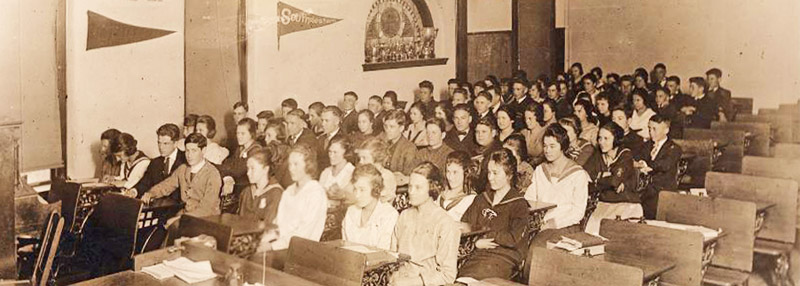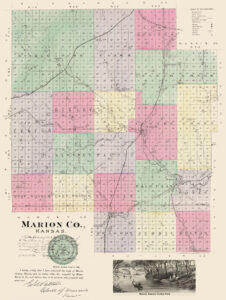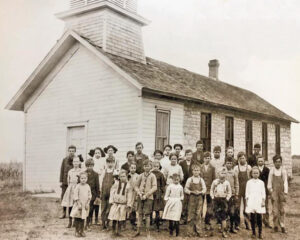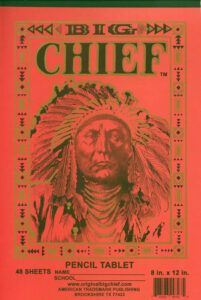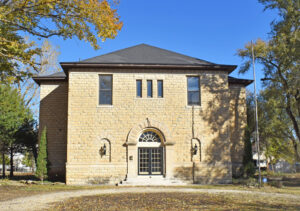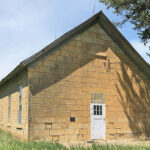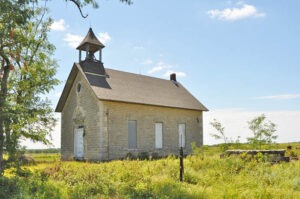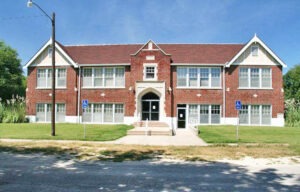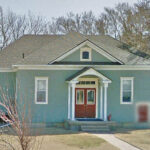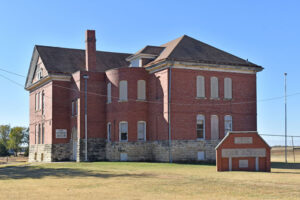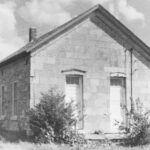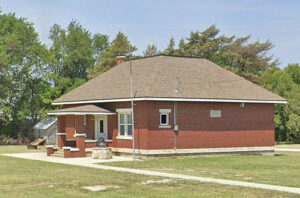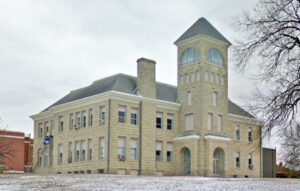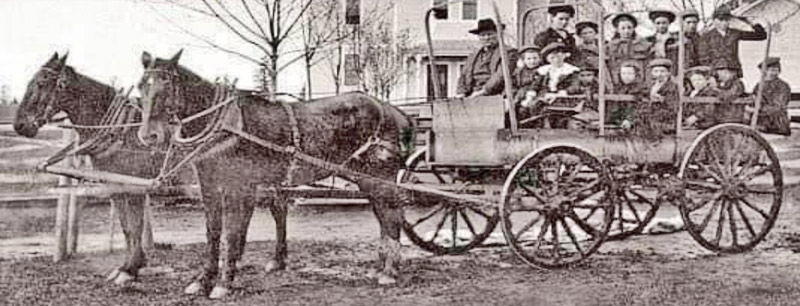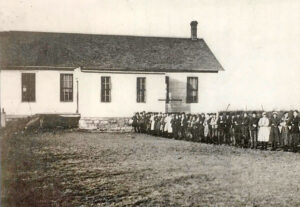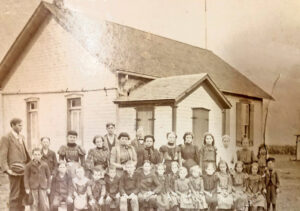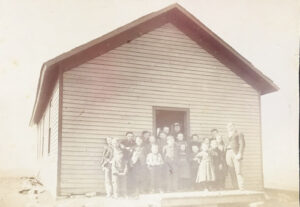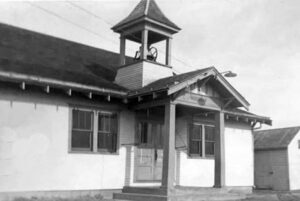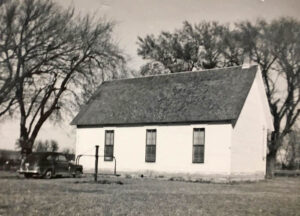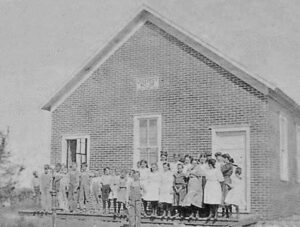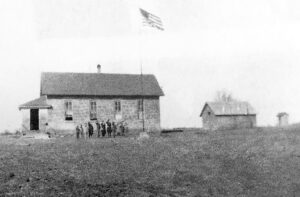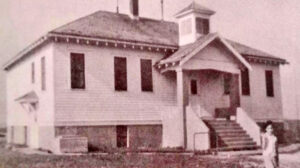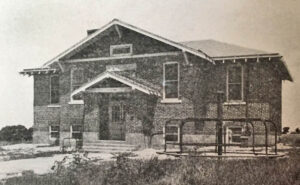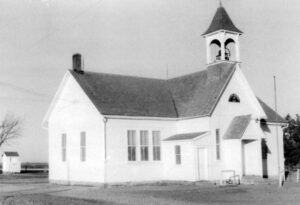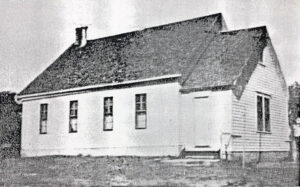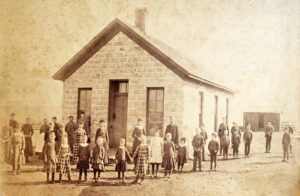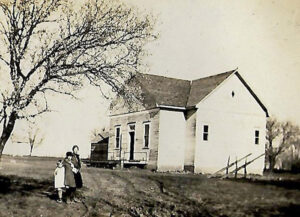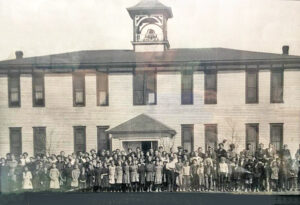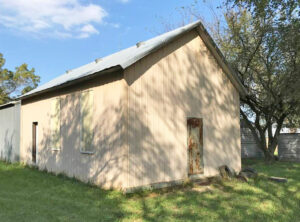Marion County, termed “a howling wilderness” in 1865, had three schoolhouses in 1871.
Dr. J. N. Rogers of Marion, Kansas, presided over the first school taught in Marion County. The building, situated opposite what is now known as William Brumbaugh Place, had been explicitly erected for school purposes. Students came from the surrounding counties, and some even from Texas. The enrollment reached 36. All of this occurred in the winter of 1865-66, before the establishment of any school district within the county’s boundaries.
School District No. 1, which encompassed the city of Marion and adjacent territory, embraced the entire county, an area of more than 1,000 square miles. In quick succession, there followed the organization of District No. 2, known as the Antelope district; then Districts 3 and 4, the former a few miles east of Florence and the latter at Florence, divided the honors with Marion and vicinity and obtained their due proportion of the school funds. For a long time, the districts in the county’s eastern, southern, and extreme southwestern portions derived revenue from the unoccupied western and northern portions. However, except for the Scully tract of land, in the northwestern part, the county is divided into school districts of convenient size.
The first schoolhouse, a substantial stone structure of four study rooms and four recitation rooms, was erected on a commanding site overlooking Marion in 1873. The first principal of the schools was Thomas M. Potter, who, for two years, strove to advance the city’s educational interests. He laid well the foundation and, refusing re-election to the principalship, retired to a farm. He was followed by T.A. Bogle, who looked after the development of the schools with fidelity for five years. Afterward, Mr. Bogle served as county superintendent of public instruction for two years and as county attorney for four more years. At the close of his service, William Bogle, his brother, was superintendent for one year. Afterward, he studied medicine and became a leading physician in Atchison, Kansas. G.A. Boyle succeeded Dr. Bogle for a one-year term and thereafter returned to teaching. Then came E.M. Donaldson, who for two years labored industriously and unceasingly to promote school interests in the city and county. During his principalship, a fine four-story stone structure was erected in the valley to accommodate many children far from the hill. These two buildings, including a one-room stone building, one mile west of the corporation limits, provided sufficient school facilities until 1889, when the original house was remodeled and enlarged into the new high school building.
The first person to serve as school superintendent in Marion County was Levi Billings, a well-known and enterprising citizen. He served one term and was followed by W. S. Moulton, who looked after the county’s school interests for another two years. Then came Dr. J.N. Rogers, who served for four years. Next, J. F. Rockafield, deputy superintendent under Doctor Rogers, succeeded him in the position he had held for one term. Following him came the first and only lady superintendent the county has ever had, Mrs. J.M. Sharon, who formed many new districts during her four years of office. David Harrison, one term; John Madden, one term; and W. B. Zercher, three terms.
In 1882, Marion County had 80 schools, one joint district with Chase County, one with Dickinson County, and one with Harvey County. At that time, it had four teachers in grade one, 62 in grade two, and 35 in grade three. The number of school-age children was 4,359; the number of male teachers was 42; the number of female teachers was 54; the average age of teachers was 22. The average monthly pay for male teachers was $36.73; for female teachers, $32.43. The bonded indebtedness for schoolhouses was about $35,000. Hillsboro employed two teachers: Florence and Peabody, four each; Marion Center, five; the other districts, one each. There were 97 rooms used for school purposes.
In 1886 and 1887, the total enrollment was 732. Succeeding him came D.W. DeLay, a veteran in this field of labor, who, for four years, carefully watched and promoted the educational interests of the city.
By the early 1890s, there were 120 organized school districts, and 126 school buildings were located within them. 153 rooms were required to accommodate the schoolchildren, and in these rooms, 153 teachers oversaw the educational interests of the future men and women of Marion County. The total school population was 7,758, of whom 5,910 were enrolled in various schools between October 1, 1891, and October 1, 1892. Of this number, 3,152 were males, and 2,758 were females. The average daily attendance during the same period was 3,885.
Every district in the county met the legal four-month school term, and the average length of the school term was nearly six and a half months. The amount raised for school purposes from July 1, 1891, to July 1, 1892, was $80,848.07; the amount expended during the same period was $68,225.28, leaving a balance of $12,622.79 to begin a new year. With school property valued at $160,000 and bonded indebtedness equal to only one-fourth of that amount, the bonded indebtedness rapidly diminished.
The wages paid to Marion County teachers were higher than in most counties in Kansas. The average monthly salary of male teachers was approximately $52, whereas that of female teachers was approximately $40. Outside of the city schools, where male teachers, acting in the capacity of superintendents or principals, received comparatively large salaries, sex cut little, if any, figure in the wages paid in the same grade of work.
The city schools of Marion County in the early 1890s were in Marion, Peabody, Florence, and Hillsboro. Lehigh, Burns, Lincolnville, Lost Springs, Tampa, Durham, Ramona, Aulne, and Canada were other village schools. Marion and Peabody were the largest schools in the county. Both had high school departments that thoroughly prepared students for the three State educational institutions: the University of Kansas at Lawrence, the State Agricultural College at Manhattan, and the State Normal School in Emporia.
The schools were under special jurisdiction and supervision, consisting of a ten-member board of education and a city superintendent.
This review of the schools would not be complete without a tribute to the wide-awake, progressive spirit shown by the teachers of this county in the formation of the Marion County Teachers’ Association, which met quarterly during the year at Marion, Peabody, Florence, and Hillsboro, in rotation.
After July 1969, the office of County Superintendent ceased operating. Legislation regarding the school unification program called for its extinction. The administrative work was moved to the state office at Topeka, Kansas, which, in turn, supervises the county schools through the superintendents of the five districts.
Marion County has five school districts today, including:
- Centre USD 397 – Headquartered in a rural area between Lost Springs and Lincolnville, the district includes the communities of Lincolnville, Lost Springs, Pilsen, Tampa, Ramona, Antelope, Burdick, and nearby rural areas of Marion, Morris, Dickinson, and Chase Counties. Centre was one of the first significant consolidations of rural high schools in Kansas that was successful. It had students from approximately 256 square miles in four counties bused to school.
- Goessel USD 411 – Headquartered in Goessel, Kansas, the district includes the community of Goessel and nearby rural areas of Marion, McPherson, and Harvey Counties. All schools are in Goessel.
- Hillsboro USD 410 – Also known as Durham-Hillsboro-Lehigh USD 410, it is headquartered in Hillsboro, Kansas. The district includes the communities of Hillsboro, Lehigh, Durham, and nearby rural areas of Marion County. All schools are located in Hillsboro.
- Marion-Florence USD 408 – Headquartered in Marion, the district includes the communities of Marion, Florence, Aulne, Canada, Eastshore, Marion County Lake, and nearby rural areas of Marion County. All grades are located in Marion.
- Peabody-Burns USD 398 – Headquartered in Peabody, the district includes the communities of Peabody, Burns, Wonsevu, and nearby rural areas of Marion, Chase, Harvey, and Butler Counties. All schools are located in Peabody.
Historic Schools in Marion County
| Name | District | Years of Operation | Location & Information |
| Arnold | 4 | 1910-1947 |
Arnold School was built in 1910 and named for Mrs. M.C. Arnold, who taught in the area for 38 years. The building was a school until 1947, after which a local veterans group used it. The veterans donated the school to the Florence Historical Society. Linda and Doug Eschelman purchased the building in 1993 and rehabilitated it as a bed-and-breakfast known as Stone Haven. It is located at 111 W. Sixth Street in Florence, Kansas. |
| Bethel | 8 | 1885-1937 |
This school is a one-story, gable-roofed, native limestone structure. A woodshed or coal shed and an outbuilding were constructed in the 1930s. A storm cellar with a concrete top is located west of the building. Bethel School’s interior comprises two bays. The entry bay contains the coatroom and is separated from the classroom by a partition wall. Students of all ages attended Bethel School until the early 1900s, when compulsory education laws limited enrollment to grades 1-8. The length of the Bethel School year fluctuated in the 19th and early 20th centuries, averaging approximately six months. The school year was extended to seven months in the 1930s, and in 1948, an eight-month school year was adopted. Bethel School served the families of School District Number 8 as a center for education, public meetings, and social events. Bethel School is located five and a half miles east of Lincolnville, |
| Bichet | 34 | 1896-1946 |
Bichet was a French settlement about four miles east of Florence. When the community’s first school, erected around 1878, burned down in 1896, a new limestone school was built that same year. Listed on the National Register of Historic Places, it continues to stand today. It is five miles east of Florence on U.S. Highway 50, just north on Bluestem Road. |
| Brown-Corby | 1930-1992 |
Built in 1929, this school was built on the site of the old Valley School. An excellent example of Late Gothic Revival architecture, it was designed by Wichita-based architect Samuel S. Voigt. The building has red brick walls with ashlar limestone detailing, projecting bays, buttresses, and stone surrounds. It retains the original wood and steel windows, which is unusual for a public school building of this age. The building was the town’s grade school for 62 years, closing in 1992. It was named in honor of Anna Bown and Jenny Corby, two long-time teachers in the Marion school district. It was listed on the National Register of Historic Places in 2015. The building now serves as apartments. It is located at 412 N 2nd Street in Marion, Kansas. |
|
| Bruderthal | 70 | 1878-1956 |
It is located in Hillsboro. In 1909, Elizabeth Ewert was the teacher. It is now a residence at 224 N. Main. |
| Burns Union School | 65 | 1905-?? |
The two-and-a-half-story Romanesque Revival red brick building was completed in time for the school’s opening in the fall of 1905. The total cost of the structure and its furnishings was $9,000. Located on Main Street in Burns, Kansas, it now serves as the Burns Historical Museum. There is a playground behind the school. It was listed on the National Register of Historic Places in March 1975. |
| Canada | 60 | 1873-?? |
Located near Canada, this building still stands on private property today. |
| Dobbs | 6 | 1873-1951 |
Dobbs was originally four miles northwest of Marion. The school was donated to Emporia State University in 1969 to serve as a museum and memorial to pioneer Kansas education. To relocate the structure, the school was dismantled and rebuilt stone by stone at its new site. It is located in Lyon County at 12 West 18th Avenue in Emporia, Kansas. |
| Ebenfeld | 20 | 1926-1960 |
This one-story red Craftsman/Bungalow-style brick school is six miles southeast of Hillsboro at 1497 Kanza Road. |
| Hill | 1873-?? |
Construction of the magnesium limestone schoolhouse was started in 1873 and opened to students in 1874. The Cost of construction was $15,000. A 500-pound bell hung in the belfry. When the school opened, grade school students used the first floor and the auditorium, while older students used the second floor. The Hill School building is the oldest in Kansas and is in continuous educational use. It was built in 1873 of native stone. It is listed on the National Register of Historic Places. It is located at 601 E. Main. |
|
| Kreutziger | 97 | 1886-1960 |
The original school was located in the small community of Kreutziger, located about five miles north of Canada, Kansas. The school now serves as a museum at 5th and Ash Streets in Hillsboro, Kansas. |
| Pilsen | 115 | 1889-?? |
The old Grade School in Pilsen, Kansas. |
| Union | 4 | 1905-1965 |
The Burns Union School in extreme southeast Marion County was Kansas’s first consolidated grade and high school. In April 1904, four districts in Marion, Butler, and Chase counties voted to consolidate. Classes began in September 1904 in the old Burns grade school and the former post office building. Students were transported from a 43-square-mile area to Burns via three special-order “buses.” This was reportedly the first use of school buses in Kansas. The new building was completed in time for the school’s opening in the fall of 1905. The total cost of the structure, including furnishings, was $9,000. The Burns Union School was the only district schoolhouse until 1921, when a new high school building was completed. The original building was still used for classes until a further unification of school districts in 1965 terminated its use. At that time, the old school building was donated to the Burns Community Historical Society for use as a museum. The Burns Union School Building is a two-story Renaissance-style structure with a full basement and an attic. A playground is behind the school. It is located at the southwest corner of Main and Ohio in Burns, Kansas. |
Marion County Historic School Districts
| Name | District | Dates | Location |
| Marion | 1 | 1865-active | Marion |
| Antelope | 2 | 1873-1959 | It was four miles south of Lincolnville. |
| Florence | 3 | 1873-1919 | It was near Florence. |
| Florence | 4 | 1873-closed | Florence. |
| Wren | 5 | 1873-1952 | It was five miles northwest of Marion. |
| Dobbs | 6 | 1873-1951 | It was four miles northwest of Marion. |
| Lincolnville | 7 | 1873-(closed) | Lincolnville is now District #397. |
| Bethel | 8 | 1875-closed | Near Lincolnville. |
| Phillips | 9 | 1873-1949 | Phillips School joined with Grape #54, and the new school was called Loveless. It was ten miles northeast of Marion. |
| Brown | 10 | 1873-1951 | It was four miles southeast of Marion. |
| Gnadenau | 11 | 1874-1956 |
It was two and a half miles southeast of Hillsboro. Risley school was there first, in 1873. It combined with Gnadenau. |
| Peabody | 12 | 1871-active | Peabody |
| Aulne | 13 | 1873-1967 | Aulne |
| Sunflower | 14 | 1873-1951 | It was four miles southwest of Marion. |
| Cresswell | 15 | 1873-1960 |
It was five miles south of Hillsboro. |
| Dickinson | 16 | 1873-1960 | It was four miles south of Marion. |
| Williams | 17 | 1873-closed | It was three miles west of Aulne. |
| Finch | 18 | 1873-1960 | It was five miles southeast of Hillsboro. |
| Thorp | 19 | 1873-1946 | It was two miles south of Aulne. |
| Ebenfeld | 20 | 1873-1960 |
It was six miles southeast of Hillsboro. |
| Pleasant View | 21 | 1875-1960 |
It was four and a half miles northeast of Marion. |
| Pleasant Hills | 22 | 1879-1951 | It was five and a half miles north of Florence. |
| Mitchell | 23 | 1874-1908 | It was near Florence. |
| Unknown | 24 | It was near Burns. | |
| Bellview | 25 | 1875-1946 | It was three and a half miles southwest of Peabody. |
| Ridge | 26 | 1875-1960 | It was nine and a half miles southeast of Hillsboro. |
| Pleasant Valley | 27 | 1875-1950 | It was six miles east of Goessel. |
| Warham | 28 | 1874-1960 | It was ten miles southeast of Goessel. |
| Bond | 29 | 1874-1946 |
It was in East Branch Township, four miles northeast of Peabody. |
| Emmenthal | 30 | 1873-1950 | It was four miles south of Goessel. |
| Goessel | 31 | 1875-active | Goessel was later District #130. |
| Green Valley | 32 | 1878-closed | It was three miles east of Goessel |
| Sand Creek | 33 | 1873-closed | It was five miles southeast of Goessel. |
| Bichet | 34 | 1878-1946 | It was 4.5 miles east of Florence. |
| French Creek | 35 | 1878-closed | It was three miles north of Hillsboro. It consolidated with District 129. |
| Hochfeld | 36 | 1878-1950 | It was three miles north of Goessel. |
| Pleasant Hill | 37 | 1873-1946 | It was two and a half miles northeast of Peabody. |
| Clark | 38 | 1873-1953 |
It was located three and a quarter miles southwest of Pilsen. |
| Bixler | 39 | 1873-1953 |
This school was three and a half miles northwest of Marion. |
| Weaver | 40 | 1873-1947 | It was five miles northwest of Peabody. |
| Morning Star | 41 | 1873-1961 | It was three and a half miles southwest of Marion. |
| Prairie Center | 42 | 1873-1946 | It was three and a half miles southeast of Peabody. |
| East Creek | 43 | 1875-1946 |
It was three and a half miles southeast of Lincolnville. It was three and a half miles southeast of Lincolnville. |
| Milton | 44 | 1873-1946 | It was four miles northwest of Burns. |
| Williams | 45 | 1875-1915 | It was two miles north of Florence (Sears). |
| Porter | 46 | 1873-1946 | It was three miles southeast of Peabody. |
| Belton | 47 | 1878-1953 | It was four miles southeast of Tampa. |
| Schlehuber | 48 | 1873-1954 | It was four miles west of Hillsboro. |
| Lost Springs | 49 | 1880-present | Lost Springs |
| Crites | 50 | 1873-1946 | It was five miles northwest of Burns. |
| Summit | 51 | 1873-closed |
It was seven miles southeast of Peabody. |
| Cross | 52 | 1873-1946 | It was two miles west of Lincolnville. |
| Antioch | 53 | 1880-closed | It was three and a half miles northeast of Goessel. |
| Grape | 54 | 1873-1949 | Grape School joined with Phillips #94, and the new school was called Loveless. It was ten miles northeast of Marion. |
| New Hope | 55 | 1875-1956 | It was two miles northwest of Aulne. |
| Fifty-Six | 56 | 1873-1958 | It was eight miles east of Marion. |
| Durham | 57 | 1875-closed | Durham combined with District 410. |
| Nusbaum | 58 | 1875-1946 | It was three miles north of Peabody. |
| Biscuit Knob | 59 | 1878-1946 |
Also called Biscuit Hill, it was four miles east of Peabody. |
| Canada | 60 | 1873-closed |
It was one mile north of Canada. |
| Youngtown | 61 | 1875-closed | It was five miles northeast of Marion. |
| Beauty of the West | 62 | 1874-1946 | It was one and a half miles southeast of Pilsen. |
| Garner | 63 | 1883-1947 | It was two and a half miles west of Tampa. |
| Fairplay | 64 | 1873-1946 |
It was six miles northeast of Peabody. |
| Burns | 65 | 1884-present |
Burns is now in District 398. |
| College Hill | 66 | 1878-1950 |
It was four miles northwest of Tampa. |
| Endeavor | 67 | 1884-1953 | It was three miles northwest of Durham. |
| Ashcraft | 68 | 1884-1953 | It was three miles northwest of Durham. |
| Rose Hill | 69 | 1884-1950 | It was 1.5 miles northeast of Lehigh. |
| Bruderthal | 70 | 1878-1956 | It was four miles northeast of Hillsboro. |
| Bruno Creek | 71 | 1878-1946 | It was four and a half miles northeast of Florence. |
| Steinbach | 72 | 1878-closed | It was four miles southwest of Hillsboro. |
| Sunrise (Hardscrabble) | 73 | 1878-1946 | Also called Hardscrabble, it was four and a half miles northeast of Florence. |
| Santa Fe | 74 | 1875-1940 | |
| Hope Valley (Hoffmungethal) | 75 | 1877-1960 |
Located in the Mennonite village of Hoffnungsthal, it was two miles south of Hillsboro. |
| Oliver | 76 | 1879-1946 | It was five miles west of Lincolnville. |
| Round Top | 77 | 1880-1946 | It was four miles southeast of Florence. |
| Light House | 78 | 1879-1951 | It was northeast of Hillsboro. |
| Lehigh | 79 | 1888-closed | Lehigh, combined with District 410. |
| Springfield | 80 | 1880-1953 | It was five miles north of Goessel. |
| Heimbaugh | 81 | 1878-1957 | It was five miles southeast of Goessel. |
| Hillsboro | 82 | 1880-active | Hillsboro, District 410. |
| Elm Spring | 83 | 1882-1953 | It was seven miles northwest of Durham. |
| Pleasant Valley | 84 | 1883-1950 | It was five miles northwest of Durham. |
| Highland | 85 | 1883-1954 | It was 5.5 miles east of Tampa. |
| Shank | 86 | 1883-1946 |
It was two miles southeast of Peabody. |
| Warren | 87 | 1883-1958 | It was three miles southeast of Durham. |
| Silberfeld | 88 | 1883-1956 |
It was five and a half miles northwest of Hillsboro. |
| Bell | 89 | 1884-1953 | It was six miles northwest of Tampa. |
| Ramona | 90 | 1884-1967 |
Ramona, now District 397, Centre. |
| Comet | 91 | 1884-1958 | It was two and a half miles southeast of Tampa. |
| Unruh | 92 | 1884-1956 | It was five miles north of Hillsboro. |
| Pleasant Hill | 93 | 1884-1947 | It was two and a half miles southeast of Tampa. |
| Square Top | 94 | 1885-1956 | It was six miles northwest of Durham. |
| Sunnyside | 95 | 1895-1950 | It was two miles southeast of Ramona. |
| Bartholdi | 96 | 1886-closed | It was four miles north of Tampa. |
| Kreutziger | 97 | 1886-1960 | It was five miles north of Canada. |
| Smith | 98 | 1887-1946 | It was two miles north of Pilsen. |
| Greenfield | 99 | 1887-1957 | It was two miles southeast of Goessel. |
| Maple Hill | 100 | 1887-1953 | It was two and a half miles southwest of Lehigh. |
| Heath | 101 | -1946 | It was four miles south of Peabody. |
| Waldeck | 102 & 103 | 1888-1958 | It was three miles northeast of Leigh. |
| Kleinhamer | 104 | 1888-1950 |
Kleinhamer School was moved to Sec 10-19-4 in 1950. It originally stood five and a half miles southeast of Lincolnville. |
| Center | 105 | 1888-1960 | It was five miles northwest of Peabody. |
| Spring Valley | 106 | 1889-1940 | It was three and a half miles south of Florence. |
| Unknown | 107 | 1888-1906 | It was near Burns. It consolidated with Burns in 1906, the first consolidation of two districts in Kansas. |
| Quarry | 108 | 1888-1951 | It was four and a half miles northeast of Marion. |
| Southview | 109 | 1900-1946 | It was four miles southeast of Peabody. |
| Tampa | 110 | 1889-1969 | Tampa is now part of Centre 397. |
| Townsend | 111 | 1889-1946 | It was three miles northeast of Peabody. |
| Hutchins | 112 | 1900-1955 | It was six miles west of Lincolnville. |
| Folsom | 113 | 1889-1947 | It was three miles northwest of Florence. |
| Red Top | 114 | 1889-1947 | It was three miles northwest of Florence. |
| Pilsen | 115 | 1889-closed | Pilsen is now part of Centre 397. |
| Hartke | 116 | 1889-1947 | It was two miles north of Lincolnville. |
| Symes | 117 | 1891-1941 | It was six miles southeast of Lincolnville. |
| Columbia | 118 | 1893-1953 | It was nine miles west of Tampa. |
| Geis | 119 | ??-1947 | It was four miles west of Durham. |
| Merry-Go-Round | 120 | 1893-1954 | It was four miles east of Durham or three miles south of Tampa. |
| Doles Park | 121 | 1900-1936 | |
| Lincoln | 122 | 1894-1924 | It was two miles south of Ramona. |
| Good Hope | 123 | 1900-1948 | It was two miles northeast of Goessel. |
| Plain View | 124 | 1900-1952 | It was three miles northwest of Lehigh. |
| Victory | 125 | 1887-1957 | It was five miles southeast of Durham. |
| Prairie View | 126 | closed | |
| Grand Central | 127 | closed | It was in northwestern Marion County. |
| Countryside | 128 | closed | Countryside |
| Suncrest | 129 | closed | It was three and a half miles north of Hillsboro. |
| Goessel, | 130 | Consolidated | Goessel |
Tabor College
Tabor College is a private Mennonite college in Hillsboro, Kansas. It is owned and operated by the U.S. Conference of Mennonite Brethren Churches and adheres to Anabaptist doctrine.
Tabor’s doors opened in 1908 with 39 students and three instructors. Before the end of that school year, enrollment skyrocketed to 104, and the faculty grew to 7. It is named after Mt. Tabor, where it is believed the transfiguration of Jesus took place and has impacted the lives of thousands of people for over a century.
In 1918, a fire destroyed the building that housed the college for its first ten years. But supporters of Tabor banded together and built two new buildings in two years. The dormitory/dining hall and an administration/classroom building were completed in 1920 and remain in use. The H.W. Lohrenz Building is named after Tabor’s first president.
From its beginning, Tabor College has offered a broad Christ-centered liberal arts education, preparing students for employment and training church workers. The first two school terms in 1908-1909 included natural sciences, mathematics, English and literature, ancient languages, history, Bible and biblical history, business, vocal music and organ, and German reading and grammar. Painting and drawing were added the following year.
Throughout Tabor’s history, the Hillsboro campus has offered an associate of arts degree, a bachelor of arts degree, a master’s degree in education, and a graduate degree in theology. Additionally, the College offers graduate and online programs.
In 1961, Reimer Stadium was built on the south side of the Tabor College campus and named after former athletic director Del Reimer. In 2008, the old stadium was demolished and replaced by Joel Wiens Stadium in 2009, a joint venture between Tabor College and Hillsboro USD 410. The 3,000-seat stadium includes new artificial football and soccer turf, a synthetic track, and a throwing area for field events, new bleachers on the home side, a new press box, and new concession stand and restroom facilities.
On March 1, 2019, it was announced that Tabor plans to relocate their online programs from Wichita to the Hillsboro campus, about 50 miles north of Wichita, Kansas.
Tabor College operates under its own charter, with its Board of Directors responsible for the Mennonite Brethren churches of the Central, Southern, Latin America, and Eastern districts.
©Kathy Alexanderer/Legends of Kansas, updated December 2025.
Also See:
One-Room, Country, & Historic Schools of Kansas
Sources:
Cutler, William G; History of Kansas; A. T. Andreas, Chicago, IL, 1883
Genealogy Trails
Kansas State Historical Society, The Columbian History of Education in Kansas, Hamilton Printing Company, Topeka, KS, 1893.
Marion County Historic Schools
Tabor College
Wikipedia

